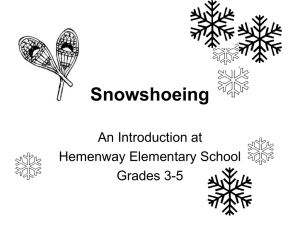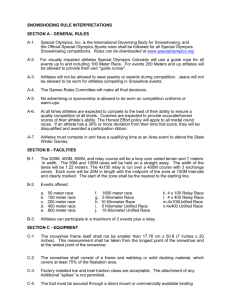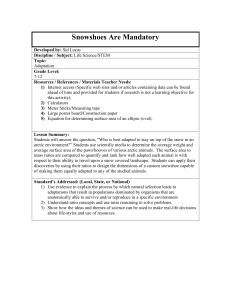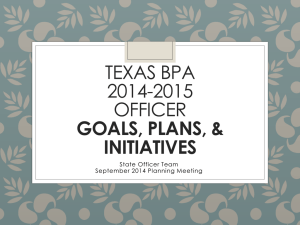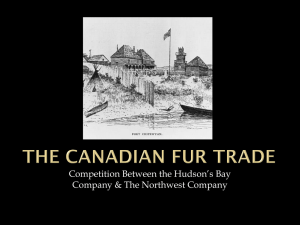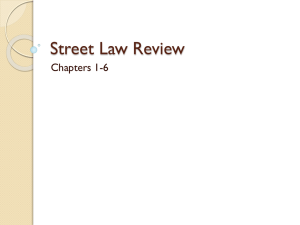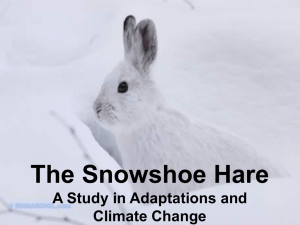Snowshoeing - Special Olympics Michigan
advertisement
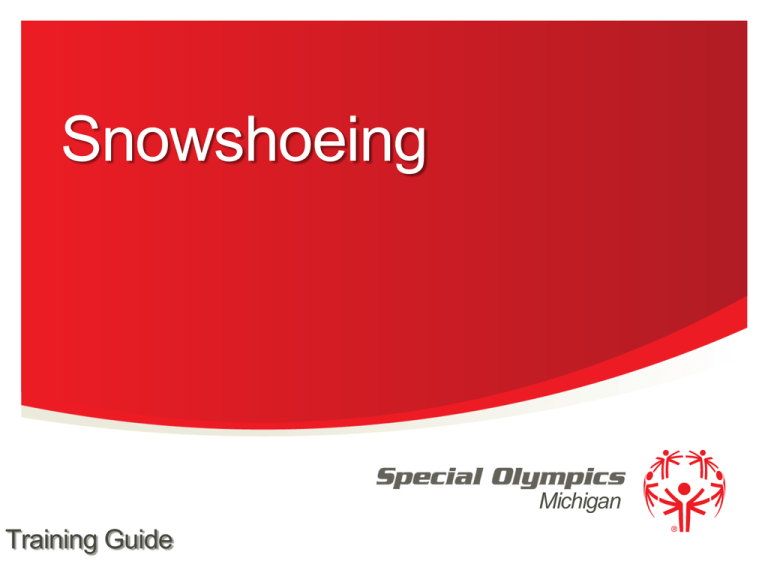
Snowshoeing Michigan Training Guide Events Offered • 30 Meter • 50 Meter • 75 Meter • 100 Meter • 200 Meter • 400 Meter 2 Special Olympics Michigan Suggestions • It is suggested that beginner athletes enter the 30-meter and 50-meter events. Intermediate athletes should enter the 75-meter and 100-meter races. Advanced athletes should enter the 200-meter, or 400-meter events. 3 Special Olympics Michigan Uniforms • Athlete should wear appropriate winter sports attire. Warm ski gloves or mittens, a hat, snow pants or bibs, scarf, headband or ski mask, and sunglasses or goggles are recommended. • Clothing should be conducive to freedom of movement. • Competitors must wear their assigned number in a position visible to the officials at all times. 4 Special Olympics Michigan Equipment • All participants must provide their own equipment. • The minimum length for snowshoes is 25 inches. Snowshoes should measure at least 8 inches by 25 inches. SOMI recommends a Michigan or Alaskan-style snowshoe. It is not necessary for showshoes to have a “tail” provided that the snowshoe meets these minimum size standards. Snowshoes may not be altered in anyway. • Athletes must use the same snowshoes during the time trial and final competition. If an athlete is found to be wearing different snowshoes during finals competition, the athlete will be disqualified and given a participation ribbon only. 5 Special Olympics Michigan Competition • Only the officials and the athletes competing in the race are allowed on the course. • Athletes begin with feet behind the start line. All snowshoe races will use the starting command, “5-4-3-2-1-Go!” At the same time as the verbal start command, a flag will be dropped to alert timers to the start and to accommodate hearing-impaired athletes. Athletes must stay within their assigned lanes. Athletes continue on snowshoes until crossing the finish line. Athletes must complete the entire distance of this course with both snowshoes on. In the event that one or both snowshoes come off, the athlete must stop, put the snowshoe back on (at the point where it came off), and then complete the course. Time is taken from the point that the competitor’s torso crosses the finish line. The finish referee is responsible for all such decisions. Competition • A competitor may not progress forward more than three meters unless they have both snowshoes attached to their feet. • An additional visual start indicator (flag) may be used to assist athletes with a hearing impairment. • Any competitor starting before the start signal is given will be charged with a false start. A false start occurs when a competitor significantly moves any body part before the start signal after coming to a still set position after the “Racers ready” command and before the starting signal. An official should identify and notify the athlete that is charged with a false start. Any competitor making two false starts in the same race will be disqualified from that race. 7 Special Olympics Michigan Competition • Pacing of competitors is not allowed. • Any competing athlete who jostles or obstructs another athlete, so as to impede his or her progress, shall be liable to disqualification from that event. The action must be judged to be intentional and beyond incidental to result in disqualification. The Referee shall have the authority to order the race to be re-held excluding any disqualified athlete. • A competitor must have both snowshoes on his/her feet when crossing the finish line to be official. 8 Special Olympics Michigan Course Set-Up • Race Course Layout for 30 meter through 100 meter Race course area should be as flat as possible and at least 30-100 meters long. • A start line should be marked, which is 20 meters long. • The finish line should be marked at 30 meters, 50 meters, 75 meters, and 100 meters from and parallel to the start line. • Six lanes should be designated, and each lane should be 2.3 meters wide. • Two 5-10 meter areas should be used for staging: one area before the start line and one area after the finish line. 9 Special Olympics Michigan Course Layout for 200-400 Meters • The minimum size of the course layout should be 400 meters in length and 7 meters in width. The course should be a continuous hoop over varied terrain. For the 200 meter race, the athlete will run over a portion of the 400 meter course. For the 400 meter race, the athlete will run one lap of the 400 meter course. 10 Special Olympics Michigan Tips for Technique: Warm up • Walking on snowshoes requires that you take longer steps than normal, especially uphill. You also walk with your feet much wider apart than normal. Lightly stretching your hamstrings (muscles on the backs of the thighs) and hip flexors (muscles in front of the hips that lift the legs) will help your flexibility for snowshoeing. 11 Special Olympics Michigan Beginner Snowshoers • Once there is sufficient snow cover to run the local trails in snowshoes, racers should incorporate two to three snowshoe 'workouts' each week. Beginners will notice there is a tendency to alter their normal gate mechanics to avoid 'clanking' their snowshoes together. Most racing snowshoe models however, are narrow enough to maintain a normal running stride. Although running in snowshoes is pretty intuitive, it is important to remember to pick your foot straight up after you've made contact with the snow. All beginners fall the first time they run in snowshoes because they tend to drag their tips. It only takes one face first plant on the trail to learn this valuable lesson. 12 Special Olympics Michigan Getting Started • Walk in your snowshoes as you would without. It is normal to have some straddle, and you'll quickly learn where to place the snowshoes moving forward (not too wide). • Once you master walking, a great way to progress is to use the run-walk method and gradually build up your running time just as you would with a new running program. Run until you're out of breath, walk until you're bored (or until you've caught your breath). 13 Special Olympics Michigan Getting Started • Be patient. Snowshoe running is far more demanding than running. It can be compared effort-wise to that of a speed workout and your pace will be much slower than your running pace. • Start running and stay relaxed letting your feet land where they will. Focus on running with your natural stride, rather than a wide (straddle) as it can cause fatigue in your thighs, calves and ankles. Stick with short intervals and work on efficiency. Running form for snowshoe runners is vital to conserving energy management (economy) and for avoiding injuries. Progress gradually and learn to become at one with your shoes. 14 Special Olympics Michigan Don’t Back Up! • Avoid trying to go backwards - you'll end up on your butt for sure. Instead, turn right or left to turn around. The cleats do a wonderful job of keeping you moving in all directions except back. To turn in snowshoes use the T step and place one snowshoe at a 90-degree angle in front of the other snowshoe. Then shift the rest of your body and the other shoe alongside the lead shoe. 15 Special Olympics Michigan Terms • Binding- The part of a snowshoe that attaches the footwear to the snowshoe • Carrying Surface- Surface area of a snowshoe; the larger the surface area, the more flotation and support for the snowshoer • Crampon- The sharp pointed traction device that may be attached to a snowshoe’s pivot hinge to prevent slippage. Generally made from heat-treated aluminum or tempered carbon steel • Fall line- Shortest distance down a slope. The direction perpendicular to the ground that an object ( you, rock, snow) would fall. • Flotation- Ability of a snowshoe to limit sinking down into soft or deep snow • Frame- The rigid outer structural component of a snowshoe, usually made of wood, plastic or metal Terms continued • Claw- Like a crampon but with comparatively short serrations. Claws are an angle traction device attached to snowshoes. They give a “grip” comparable to that provided by the webbing of traditional snowshoes and are used in conditions where ice or steep surfaces are not encountered. • Decking- Solid or webbed pieces of nylon, rawhide or rubber-like material attached to the snowshoe frame that provides flotation for the snowshoer • Heel Strap- Part of the snowshoe binding that secures the heel. It is a strap that wraps around the back of the snowshoer’s footwear • Lamp Wick- A 1 ½ inch cotton woven cord (oil lamp cord) used for binding snowshoes. • Pivot Rod- Attaches to the frame and allows the foot and binding to rotate as the snowshoer • Tail-The rear area of a snowshoe frame 17 Special Olympics Michigan Terms continued • Tip or Toe- The front area of a snowshoe frame • Toe Hole- The opening in the front decking that allows the forefront to pivot through a complete range of motion • Tuque- A knitted hat adorned with a tassel on the top, the traditional headgear for snowshoers 18 Special Olympics Michigan
